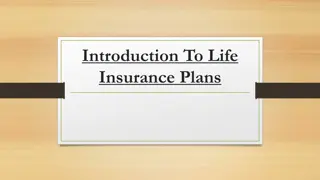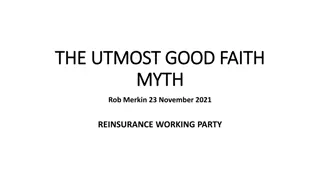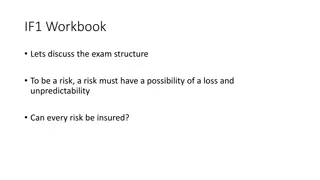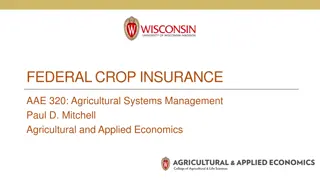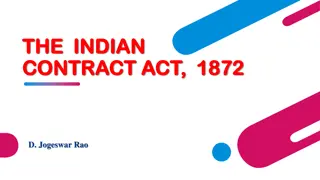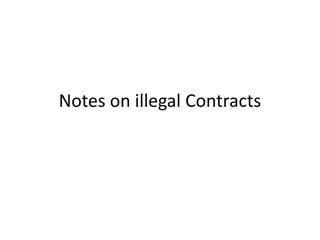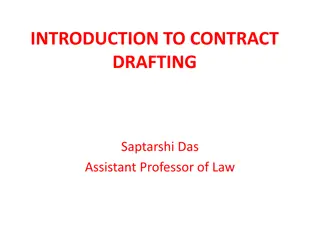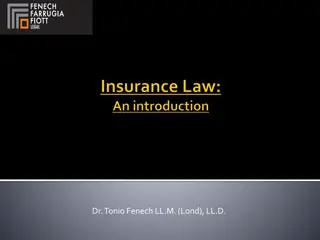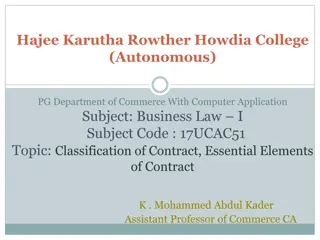Understanding Different Types of Insurance Contracts
This unit delves into the various kinds of insurance contracts, focusing on life insurance and non-life insurance classifications. It covers essential topics such as property and liability losses, workers' compensation, social insurance versus private insurance, and direct insurance versus indirect insurance. Gain insights into different provisions, conditions, and features of life insurance, along with the significance of insurance in protecting individuals and businesses against diverse risks.
Download Presentation

Please find below an Image/Link to download the presentation.
The content on the website is provided AS IS for your information and personal use only. It may not be sold, licensed, or shared on other websites without obtaining consent from the author. Download presentation by click this link. If you encounter any issues during the download, it is possible that the publisher has removed the file from their server.
E N D
Presentation Transcript
Unit- 4 KINDS OF INSURANCE Prepared By: YT 1
4.1 Introduction As it is discussed in the previous units, there are large numbers of risks that surround our day- to-day life or our business operation. Among these only few have got insurance coverage. The diversified nature of the insurable risks also demands different provisions and conditions, resulting in large number of insurance contracts or policies. In this unit, we will discuss the different type of insurance contracts (property and life) how ever; more time will be devoted in the discussing life insurance contract, its features and provisions and condition that apply to it. Prepared By: YT 2
4.2 Classification of Insurance Insurance can be classified as follows; 1. Life insurance Vs Non- life Insurance A. Life insurance Life/ personal insurance sell on the individual persons. Human lives are insured under this insurance. It also includes supplementary policies that sells to protect households against a loss of earning from disability (disability insurance); injury or incurring a disease (health insurance and living a certain period (endowments, annuities, and pensions). B. Non- Life Insurance Non-life/property/ general insurance sell insurance to protect property. Non- life insurance companies sell polices to protect households and firms from the risks of theft, fire, accident, or natural disaster. Prepared By: YT 3
4.2 Classification of Insurance (Cont) It includes insurance to cover 1. Property losses (i.e., damage to or destructions of homes, automobiles, business, aircraft, etc) 2. Liability losses (i.e., Payments due to professional negligence, product defects, negligent automobile operation etc. 3. Workers compensation payments. and health insurance Prepared By: YT 4
4.2 Classification of Insurance (Cont) 2. Social Vs Private Insurance A. Social Insurance The social insurance is meant to protect and uplift the weaker sections of the society and may be in different forms like pension plans, disability benefits, unemployment benefits, sickness insurance, industrial insurance etc. premium under such insurance schemes is paid by the government or the employers or by both. In some cases the employees or beneficiaries also contribute their share of the premium. B. Private Insurance Private insurance emphasizes individual actuarial equity, i.e., premiums reflect the expected value of losses. Most private insurances are voluntary although the purchase of some insurance is required by low. A major part of social (governmental insurance) is involuntary, i.e., it is required by low to be purchased by certain groups under certain conditions. Prepared By: YT 5
4.2 Classification of Insurance (Cont) 3. Direct insurance Vs indirect Insurance Direct Insurance: is life or non- life insurance sold to public and to non-insurance commercial and individual enterprises. Indirect Insurance (Re-insurance): is sold by direct writing insurers to hedge their own portfolio. Prepared By: YT 6
4.2 Classification of Insurance (Cont) The difference between life insurance and general insurance (non- life insurance). The following are some of the factors that differentiate life insurance from property (general insurance); A. Risk The occurrence of risk (death) in life insurance is certain. But in other insurance the occurrence of the risk insured is uncertain. B. Procedure Life insurance requires medical certificate where as survey is made before a property is insured. C. Premium and Amount Since it is difficult to express life in monetary terms the amount insured depends on the personal requirements of the insured. The insure also charges the insured a premium determined according to the age and heath condition of the insured. But in other forms of insurance the premium is determined according to the risks involved. The amount of the policy in the property insurance can be taken up to the value of the property . Prepared By: YT 7
4.2 Classification of Insurance (Cont) D. Insurable interest and transfer of the policy Insurable interest principles is applicable to both life and non- life insurance. However, the time of its requirement may vary. In other words, insurable interest must exist at the time of purchase of a life policy. In marine police such interest must exist at the time of loss and in fire insurance both at the time of taking the policy and at the time of loss. A life insurance policy can be transferred either by assignment or by nomination. But in other insurances. The financial right can be transferred only by assignment with prior permission of the insurer. E. Contract General insurance contracts are contracts of indemnity, whose purpose is to recover the loss. But life insurance is not a contact of indemnity and and subrogation. The amount of compensation is the insured sum in life insurance and life insurance is never a protection against partial loss as compared to the other forms of insurance. F. Elements and purposes of Insurance Life insurance contains both elements of protection and savings (investment). However, in other insurances the investment part is totally absent. Its purpose is simply the protection of the property. Prepared By: YT 8
4.2 Classification of Insurance (Cont) 4. Double Insurance Vs Reinsurance Double insurance: It implies that the subject matter of insurance has been insured with two or more insurers or with the same insurer under two or more policies. In this case of life insurance, the insured can insure his life with many insurers as he likes for any amount and up on maturity of the policies he can collect amount of all policies from all insurers. This is possible because life insurance s not contract of indemnity since life is priceless. In the case of property insurance, this situation is handled by the principle of contribution and indemnity. Prepared By: YT 9
4.2 Classification of Insurance (Cont) Reinsurance It is a process by which an insurer transfers a part of his risk on a particular insurance by insuring it with another insurer or other insurers. It means insuring against by the insurer of a risk already insured. It is a contract between two insurers and the original contract or the insurer of a risk already insured. It is a contract between two insurers and the original contract or the insured is not at all affected by it. In this case there are two contracts on the same subject matter. These are; The contract between the original insurer or direct insurer and the owner of the subject matter or the original insured. The contract between the original insurer (re- insured, ceding company or principal insurer) and the reinsures (guaranteeing company). In the event of loss, the original insurer collects the insured some from the re- insurer and then settles the less value in full to the original insured. Prepared By: YT 10
4.2 Classification of Insurance (Cont) The major differences of double insurance and re-insurance are 1. The reinsurance business is entered into by the original insurer with other insurers. But in double insurance the insured gets the same subject matter insured with more than one insurer or under more that one policy with in the same insurer. 2. In double insurance the insured can claim only his actual loss from each of the insurers up to the amount insured with them. But in re- insurance the insured cannot claim any part of his loss from the insurer. 5. Over-insurance Vs Under-insurance When the insurance is taken for more than the value of the property under one or more policies, it amounts to over- insurance, where as when insurance is purchase for values less than the value of the property, it amounts to under insurance. Over insurance is not advantageous because only the actual loss subject to the value of the property is claimed from the insurer when the risk occurs. Prepared By: YT 11
4.3 Life Insurance Life insurance is one of the most common form of insurance. It has gained greater acceptance all over the world. Following the liberalization of the economy of the country in 1993, private insurance companies has emerged in Ethiopia; this is encouraged and motivated the society to use life insurance policies. The main purpose of life insurance is financial protection of the dependents of the insured and saving for an old age, to cover personal loan and tuition fees for education expense. Prepared By: YT 12
4.3 Life Insurance (Cont) 4.3.1 Definition Commercial code of Ethiopia defines life insurance as a contract by which the insurer, for a certain sum of money or premium proportioned to the age, health, profession, and other circumstances of the person whose life is insured engages that, if such person shall die with in the period limited in the policy, the insurer will pay according to the terms specified there of, to the person in whose favor such policies are granted. From this definition we can consider the following important features of life insurance. 1. Life insurance, like other insurances, is a contract between the insurer the insured whose life is insured or some one who has an insurable interest. Prepared By: YT 13
4.3 Life Insurance (Cont) 2. Its purpose is financial protection of the dependents of the insured with financial compensation amounting the sum assured if the insured die while the policy is in force. Of course, life insurance may also be engaged in encouraging savings to accumulate an educational fund that could be used to pay tuition fees for children when they join higher education, and to settle an outstanding balance of a debt. 3. The insurance charges premium based on age, sex, health condition, occupation and other criteria. 4. Life insurance policy gives protection against special types of risks i.e., death whose occurrence is certain. The uncertainty is related to the causes and time of death. 5. The benefit, financial compensation up on death is determined in advance based on the decision made by the insured and reasonableness of the premium. Prepared By: YT 14
4.3 Life Insurance (Cont) 6. The insured and policy owner may be different. For example, an individual may insurance the life of another person, if, he/she has a financial interest. 7. Life insurance is not strictly a contract of indemnity. Because life is priceless. For this reason, if the insured buys more than one policy all of the insurance companies will indemnify fully. 8. The probability of claim for compensation increases with the passage of time due to insured s deteriorating health conditions as they grow old. Prepared By: YT 15
4.3 Life Insurance (Cont) 4.3.2. Kinds of life insurance policies According to the duration. Life insurance policies may be of the following kinds. 1. Whole- Life Policies/Contracts This policy provides financial protection to the dependents of insured up on the event of his death. The policy will mature for payment only on the death of the assured or as an exception on the death of his attaining 100 years of age. In other words, the insured can. pay premium as long as he/she lives or payment of premium may be made for a specified number of years such as up to retirement date. Whole life policy provides permanent protection to the insured s dependants in the event of death and it also allows for the accumulation of savings over the life of the insured. Prepared By: YT 16
4.3 Life Insurance (Cont) A. Ordinary whole life policy Under ordinary whole life policy, also known as straight life insurance, the same amount of premium is to be paid at a regular interval, usually annually until the death of the assured or until the achievement of the specified age limit i.e., 100 years. This policy provides life time or permanent protection at a lower cost/premium. B. Limited payment whole life insurance Under the limited payment whole- life policy the premiums are paid for a limited or selected period of time, which is determined in advance (say 10, 15, 30 years or up to the retirement age of the insured). But the policy will mature for payment only on the death of the assured. That means, after the expiration of the specified period, the policy is said to be paid up and no more premium payment is required to keep the policy in force until the death of the insured. Limited payment life insurance is desirable when new intends to stop premium payments after reaching a given age level, usually up on retirement, but wants to keep the policy in force until his/her death. The insured pays a higher premium than he would be required on ordinary life plan .because premium is paid only for a limited number of years in the limited pay insurance plan. Prepared By: YT 17
4.3 Life Insurance (Cont) C. Single- payment whole life policy In this policy premium is paid in a single installment at the purchase of the whole life insurance. This mode of payment is not preferred by most buyers. Both the premium payments have the same goal. They reach at the same destination. However .the straight pay is better for the insured if the person dies early because she/he pay smaller amount as compared to the other two modes of payment. On the other hand, if the person terminates the contract, the single pay provide a higher cash value. 2. Term Insurance The term insurance is issued to provide death benefit to the beneficiary if the insured dies with in the specified time period stated in the policy. This police matures for payment only on the death of the insured with in the term period, but if he/she survives the policy will expire and nothing is payable to the insured. The policy provides only temporary protection and has no saving element another important feature of this policy is that since it is relatively low. Prepared By: YT 18
4.3 Life Insurance (Cont) Term policy is issued for short term ranging from few months to a specified number of years such as 10 years, 15 years, 20 years etc. This insurance also often used when maximum coverage is desired at a minimum premium payment. The following are the different types of term insurance policies. i. Level term policy The policy provides a constant sum assured (amount of money payable in the event of death) though out the term of the policy. For example, under a 20 year term policy of br. 50000, the amount of payment / compensation to the insured s beneficiaries will be birr50000 if the insured dies at anytime during the term of the policy. Prepared By: YT 19
4.3 Life Insurance (Cont) ii. Decreasing (or diminishing) Term policy In this policy the amount of claims to be paid to the insured decreases periodically. These policies are usually issued to borrowers of money and the amount of the policy payable at the end of each year is automatically reduced and is equal to the outstanding loan which will be paid if the insured dies before the end of the term. This is also known as mortgage- Redemption Policy. These types of policies provide financial protection to the policy holder (creditors) and the dependents of the debtor who are supposed to cover the debt otherwise. Premiums for such type of policies are paid at the beginning of the policy. The following are types of decreasing term policies A. Mortgage Protection Insurance Mortgage protection insurance is issued in connection with real estate loans made by banks. It gives financial protection to the creditor and the dependents of the debtor of the outstanding mortgage loans in the event of accidental death of the debtor. Since a mortgage loan is paid on an installment basis, the outstanding loan decrease over time. As a result the sum assured decreases and finally becomes zero. This is why it is called decreasing term insurance Prepared By: YT 20
4.3 Life Insurance (Cont) B. Credit life insurance Credit life insurance is issued to give protection to a lender/borrower s dependent of the unpaid balance of a credit transaction if the borrower s dies before setting the unpaid balance of his debt. C. Credit Cooperative insurance This policy is issued to protect savings and credit associations from facing a financial losses on the loans they provide to their members, due to death before setting his/her debt. iii. Renewal (Renewable) Term policy This is a term policy that can be renewed after the expiry of the term with out medical examination but at a different rate of premium applicable to the age level reached at the time of renewal .for instance, a one year term policies require renewal every year. Similarly, a10 year term policy may be renewed up on its maturity. Prepared By: YT 21
4.3 Life Insurance (Cont) iv. Convertible Term Policy Under the convertible term policy an option is available to the insured to convert it into whole life or endowment life police with out going in for new medical examination .however, the premium may be adjusted either at the attained age at the time of conversion of the term policy or using the initial policy issued. To make the conversation process simple, the following requirements are to be met up on conversation. 1. There will not an increase or decrease in the sum assured. 2. Conversion will have to be made with in a specified period, usually before the maturity date of the term policy. v. Non- convertible term policy Under this non- convertible term policy an option is not available to the assured to convert into other forms of life insurance contracts. The police expire up on maturity. However, it gives the policy holder the option to renew it up on expiration. Prepared By: YT 22
4.3 Life Insurance (Cont) vi. Increasing Term Contract Under this policy the sum assured can be arranged each year to correspond to a need of the insured that increases periodically. On the basis of mode of premium payment, term insurance policies can also be classified as. a) Level Premium Policy or Regular Premium Policy- the level premium policy requires the payment of premium regularly in equal installments at fixed intervals throughout the policy such as monthly, quarterly or yearly. b) Limited Premium Policy- the payment of premium is limited to a period of attaining certain age of the assured, say retirement age. c) Single premium policy- single premium policy requires the payment of all the premium only once in a lump sum at the policy is issued. Prepared By: YT 23
4.3 Life Insurance (Cont) 3. Endowment Insurance Policy Endowment policy is issued for a fixed period (endowment period) and premium is payable during that period only. This policy provides protection of the beneficiary of the insured if he/she dies within endowment period. In addition, it provides for the payment of the face value of the policy to the insured if he/she is living at the end of the policy period. This period is known as a modified form of whole life insurance policy. The period of this policy is shorter than that of whole life insurance and hence the premiums are higher for the same age level. In general, the shorter the endowment period, the higher the premium will be. Prepared By: YT 24
4.3 Life Insurance (Cont) One important advantage of this policy over that of term policy is that the insured can terminate the contact at anytime and can collect the cash value in a lump sum which normally becomes positive after two or more years. The policy , there fore, has dual purpose; financial protection and accumulation of funds for possible contingencies in the future. Unlike the term insurance whose purpose is only protecting the insured s dependents up on the death of the insured, endowment policy helps insured s to save money for some other purposes. Another advantage of endowment policy is that it provides the assured with loan facility after the policy acquires cash value. Prepared By: YT 25
4.3 Life Insurance (Cont) The following are the different types of endowment policies. Ordinary Endowment Policy This policy will mature for payment on the survival of the assured on the date of maturity or on the date of his death with in the endowment period. This means payment to the insured or his dependents is certain whether or not he dies before the policy matures or survives the endowment period. Pure Endowment policy The pure endowment policy will mature only if the insured person survives the endowment period. In other words the sum assured is payable only if the insured survive beyond the endowment period. In this case, payment to the insured is uncertain. The objective of this policy is to benefit the insured himself rather than his dependents. As a more of an investment than protection. Prepared By: YT 26
4.3 Life Insurance (Cont) 4. Supplementary Insurance policies Supplementary policies as their name suggests are issued only in conjunction with the main life insurance policies i.e., term whole life or endowment for additional premium for each contract. Supplementary policies also known as RIDERS. The supplementary contracts. Include; Supplementary accident insurance Total and permanent disability benefit Supplementary group accident insurance. Prepared By: YT 27
4.3 Life Insurance (Cont) 4.3.3. Provisions of life insurance The policy conditions and provisions in life insurance that must be agreed by all parties of the contract include the following. 1. Contract documents; the life insurance contract requires documents such as the proposal form, the policy term, the medical report and any other supplementary contracts. 2. General information; the general information relates to the granting of insurance which is based on the following factors for selection of lives. o The build; it relates to the present condition of health and physical build, such as height, weight and other measurements of the life to be insured. o Physical condition; the medical examiner s report will reveal the physical condition of the life to be insured. o Personal history; relates to the records of illness suffered, accidents met with, surgical operations undergone , etc by the life to be insured. Prepared By: YT 28
4.3 Life Insurance (Cont) o Habits and temperaments o Moral hazards o Hobbies or avocations o Family history o Occupational hazard o Age, sex o Residence and the like These are the factors used to assess the insurability of individual or group lives. Prepared By: YT 29
4.3 Life Insurance (Cont) 3. Payment of premium; one of the responsibilities of an insured is to pay the premium agreed at the time of the contract. Payment can be made in different arrangement such as annually, semi-annually, quarterly or monthly. In an annual premium payment arrangement, the insured is expected to pay in advance. However, the insured have the following privileges; Grace period; the insured will usually receive a notice of reminder for the payment of premium on the due date for the payment of yearly, semi-annually or quarterly premium not for the monthly payment premium. Usually 30-day grace period is given to the insured. If death occurs with the grace period, the total sum assured less the outstanding premium will be payable to the beneficiary. Prepared By: YT 30
4.3 Life Insurance (Cont) Non-forfeiture options; as explained earlier, the cash surrender value of a life insurance contract (whole life and endowment) is the amount the policy owner could receive if the policy is surrendered to the insured prior to the insured s death. If the policy owners discontinues payment of premiums. He/she can use the cash value to keep the policy in force under the automatic premium loan provision. The insurer will allow the policy to continue automatic premium out of the net surrender value. Loan provision; it permits the policy owner to borrow against the policy s cash surrender value. Methods for determining the upper limit on the borrowed amount vary among policies. Prepared By: YT 31
4.3 Life Insurance (Cont) 4. Policy conversions; a policy change clause permits the insured to convert the policy with out demonstrating evidence of insurability to some other form requiring a higher premium. 5. Restrictions; A life policy is subject to the following restrictions; Occupation; all policies are free from all restrictions as travel, residence and occupation except where a propose has at the time of proposal an intention to take up a hazardous occupation or the propose is a student. In all such causes, policies will be issued subject to a suitable endorsement and, if necessary, extra premium will be charged to cover any additional risk, if any. Prepared By: YT 32
4.3 Life Insurance (Cont) Suicide- if the insured commits suicide within one year of taking insurance, noting is payable to the beneficiary. In the absence of a suicide clause, adverse selection could occur when a person contemplating suicide takes out a large amount of coverage shortly before committing suicide. The suicide clause makes this type of adverse selection unlikely. Proof of Age as the premium is charged on the basis of age of the propose, proof of age by any one of the prescribed certificates should be submitted a long with the proposal invariably where the age of the life insurance at entry is found to be lower than the age given in the proposal form, the premium shall be payable at the correct age and the excess premium already collected will be refunded. On the other hand, if it is higher than the age given in the proposal form, the difference between the premium for the correct age and original premium already paid will be collected with in a certain interest rate. Prepared By: YT 33
4.3 Life Insurance (Cont) 4.3.4 Life Insurance Premium Determination The determination of a price for insurance is a complex activity and involves the incorporation of a mathematical analysis into competitive business decision processes. This price is known as premium, which may be paid annually, semi annually, quarterly or monthly. Life insurance premium are influenced by the following major determinants; 1. Expected mortality rates in the insured population. The morality table can be prepared from the census records or from the records of the first class insurance companies. Prepared By: YT 34
4.3 Life Insurance (Cont) 2. Investment income earned by the insurer on invested premium income- interest factor. Life insurance is a long term contact and premium so received is invested in securities or deposited in a bank yielding interest. Such income may help reduce the cost of insurance. So interest earning is also a factor for calculating the premium rate. 3. Expenses incurred in operating an insurance enterprise and in providing insurance related services. The expense includes policy expenses. Commission to against, cost of preparing policy, administrative and local charges loaded, and other service charges. 4. Other factors required to determine premium rate include; age and sex of the insured, period of the insurance policy, and sum assured. We will illustrate using a hypothetical example how these determinants are incorporated into rates for life insurance coverage. But first let us discuss the following terms. Prepared By: YT 35
4.3 Life Insurance (Cont) o Net Premium; the net premium is a rate determined based on the mortality and interest rates only. No consideration is given for expense incurred and the future contingencies. The net premium is an amount of money collected by the insured to meet only death claims. o Gross Premium; gross premium includes all the insured s costs of running the business known as loading. These costs include operating expenses. Commissions, advertisement expenses, etc. so if these expenses and the expected profit to policy issuer are added to net premium, it becomes gross premium, also known as the office premium. It is a premium the policy holder actually pays to the insurer to keep the policy in force. Gross premium = Net Premium + Loading Loading: Loading of the premium refers to the process of adding expenses to the net premium. In the next section of this unit, we will illustrate how to determine premium for the life insurance using a hypothetical exercise. Prepared By: YT 36
4.3 Life Insurance (Cont) you are given the following information According to the 1995 Ethiopian central statistic office of mortality table, out of an initial population size of 1,500,000 male people of Bahir Dar city, 100,000 live at the age of 40. the number of people expected to die at age 40 is 500. this means that the probability of death at age 40 will be 500/100,000= 0.005or 0.5% Assume that Ethiopian insurance cooperation issued a one year term insurance to these entire male individuals aged 40 for death benefit of birr. 10,000each. Death claim is to be paid at the end of the term and premium is collected at the beginning of the policy. interest rate is 3% Each insured is assumed to bring the same level of risk to the group. Required; based on the information given, how much premium the insurer should charge each insured? (Net single premium) Illustration 1; 1. 2. 3. 4. 5. 6. Prepared By: YT 37
4.3 Life Insurance (Cont) Solution; Expected Death Benefit (Amount) = (No of insured expected to die)x (the sum assured death benefit/insured) = 500x 10,000 = birr 5,000,000.00 This is an amount expected to be paid by EIC at the end of the one- year term. The question here is how much money EIC need to collect from premium payments to satisfy this death claim? The answer is the present value of the future death claims, because money has a time Present value (PV) = Amount (A) x (1+r)-n PV = A = A (1+r)-n (1+r) n where; PV= Present Value A= n= number of periods Given; r= 0.03=3% A= 5,000,000 n= 1 year PV of claims= A (1+r)-n = 5,000,000 (1.03)-1 = Br,4,854,368.93 o o Amount (Future Value) r = Interest Rate per period Prepared By: YT 38
4.3 Life Insurance (Cont) This (Br,4,854,368.93) is the total net premium that EIC is going to collect from the insured s at the beginning of the policy. The net single premium (NSP) can be calculated by dividing the present value of premium collected by the number of insured at the age of 40. NSP= PV of the expected total claim No. of policy holders (insured) = 4,854,368.932 100,000 = 48.54 The amount that EIC will collect from each insured can Br. 48.54 and total of Br. 4,854,368.93 at the beginning of the term which will grow to Br. 5,000,000 in one year at 3% interest rate. The 48.544 Birr does not including Loading. The insurer may charge a fixed sum of money or certain percentage of the net premium. For example , if the insurer charges each insured 20 % of the net premium as an additional cost, the gross premium will be Birr 48.544 + 0.2(48.54)= 58.25Br. Prepared By: YT 39
4.3 Life Insurance (Cont) Illustration 2; based on the above information and the following mortality table answer the questions that follow; Year Age No. of living Number of dying 1. 40 100,000 500 2. 41 99,500 750 3. 42 98,750 1,250 4. 43 97,500 1,500 5. 44 96,000 --- Assume that the 100,000 population has purchase a 4 year term insurance at the age of 40 for a sum assured equal to Br. 10,000. Required; determine A. the net single premium (NSP) of term insurance B. the net level premium (NLP) of Term insurance C. the net level premium of pure and ordinary endowment D. the total gross premium, if 40% of the gross premium is the cost of running the business (loaded amount). Prepared By: YT 40
4.3 Life Insurance (Cont) First we can calculate the probability of dying and the expected death claims in each of the years during the term of the policy as follows: As it is discussed above, the insurer will not collect birr. 40,000,000 from the insured's. Rather it will collect the present value of the claims. The calculate is shown as follows; A) B) No. Age No. of Dying (1) Prob. of Dying Amount of Policy (2) Expected Death Claim (1x2) PV* Factor at 3% (b) 0.9709 PV of Claim C = (axb) Annual Net Premiu m** 48.55 1 40 500 0.005* 10,000 5,000,000 4,854,500 2 41 750 0.0075 10,000 7,500,000 0.9426 7,069,500 70.70 3 42 1250 0.0125 10,000 12,500,000 0.9151 11,438,750 114.39 4 43 1500 0.015 10,000 15,000,000 0.8885 13,327,305.72 133.27 Total Expected Claims 40,000,000 36,690,055.7 366.91 Probability of Dying = No. of Dying = 500 = 0.005 No. of Living at the Age of 40 100,000 Note: *Present Value of 1 Birr = 1 = 1 = (1.03)-n (1+r)n (1+0.03)n Prepared By: YT 41
4.3 Life Insurance (Cont) So when n=1, the present value of 1 birr is (1+0.03)-1 = 0.9709 and when n=2, the present value is 0.9426 and so on as shown in the table above in column b. ** Annual premium is calculated by dividing the present value by the number of insured (i.e. , 100,000). For example, 4,854,500/100,000=48.55. when we add the annual premium per insured of the four years, we can find the total Net Single Premium, which is equal to Br. 366.91(48.55+70.70+114.39+133.27) or we can divide the total present value by the number of insured at the beginning of the policy period, which gives: Net Single Premium= 36,690,055.7 100,000 NSP = 366.90 Prepared By: YT 42
4.3 Life Insurance (Cont) It is also possible to use actuarial formula to calculate the net single premium. The following variables are used in the calculation of the NSP. NSP= dx dx + 1 dx+t S lx + S lx + ...+ S Lx (1+r)1 (1+r)2 (1+r)t Where: t= time in years x= Age at a time of insurance purchase Lx= number of people living during age x dx= number of people dying during age x Px= probability of dying during age x 1- Px= probability that an individual survive at age x S= sum assured r= interest rate Using this formula NSP of the above exercise is computed as of the follows: Prepared By: YT 43
4.3 Life Insurance (Cont) NSP= 10,000 500/100,000 +10,0000 750/100,000 + 10,000 1250/100,000 + 10,000 15000/100,000 (1.03)1 (1.03)2 (1.03)3 (1.03)4 = 48.54 + 70.70 + 114.39 + 133.27 = 366.90 B) Determine the Net Level Premium (NLP): NLPis an equal annual premiums paid by the insured. Some life insurance policies may allow the insured s to pay annual premiums of equal size. In this case, all the policy holders may not pay all the annual level premium. Because some of them are expected to die before the end of the policy period. Another point here is that the insurer will collect limited amount of premiums to invest at the beginning of the policy. As a result the annual net level premium paid by the insured under this arrangement is greater than the single premium paid at the beginning of the policy. The NLP is calculated as follows: 1. Assumed each insured pays constant premium of Br. 1 throughout the term of the policy. 2. Determine present value of Br. 1 collected from each insured. 3. Divide the total present value of Br. 1 by the number of insured's to arrive at the present value of Br. 1 premium payment per insured. 4. Divide the NSP by the present value of Br. 1 premium payment per insured. This gives you the net level premium. The following next tables shows the calculations. Prepared By: YT 44
4.3 Life Insurance (Cont) Year Age No. Of insured s paying premium Br. 1 premium collected from each insured 100,000 99,500 98,750 97,500 PV of Br. 1 to be collected at the beginning of the year PV of Br. 1 premium 1 2 3 4 40 41 42 43 100,000 99,500 98,750 97,500 1 100,000.00 96,604.55 93,081.35 89,226.31 378,912.21 0.9709 0.9426 0.9151 Total PV of 1 Br. Premium = 378,912.21 Payment per insured 100,000 = 3.789 Br. Prepared By: YT 45
4.3 Life Insurance (Cont) Therefore, NLP = NSP = 366.91 = 96.84 Br. PV of Br. 1 premium per insured 3.789 Therefore, each insured is expected to pay Br. 96.84 every year for four years in order to get coverage of Br. 10,000 in the event of death. Actuarial formula can be used to find the present value of Br. 1 premium payment. The formula is given as follows: PV of Br. 1 premium payment = PL . Pv factor Actuarial formula can be used to find the PV of Br. 1 premium payment. The formula is given as follows: PV of Br. 1 premium payment = PL xPV factor Where: PL = Probability of Living Pv factor = Present Value factor = (Lx/Lx) + (Lx+1/Lx) + . + (Lx+t-1/Lx) (1+r)0 (1+r)1 (1+r)t-1 Prepared By: YT 46
4.3 Life Insurance (Cont) Accordingly, the PV of Br.1 annual premium payment for four periods become: PV of Br. 1 premium payment = 100,000 99,500 98,750 97,500 100,000 (1) + 100,000 (0.9709)+ 100,000 (0.9426)+ 100,000 (0.9151) = 1+ 0.966+ 0.9308+ 0.8922 = Br. 3.789 Note: The total present value of premiums collected from the insured s will be the same whether net single premium or net level premium is charged. Prepared By: YT 47
4.3 Life Insurance (Cont) C) Pure Endowment The NSP and NLP for pure and ordinary endowment using the information given above can be calculated as follows: Pure Endowment Policy Under the pure endowment policy, the insurer expects to pay the face value of the policy, Br. 10,000, if the insured survives the policy period. Accordingly, it would be necessary to determine the probability of survival for the insured. Survival Rate= Number of Persons Living at Age 43 (End of the Policy) No. of Persons Living at Age 40 (Beginning of the Policy) Out of the 100,000 people insured at the age of 40, 96,000 of them are expected to survive at the end of the policy period. Then, the probability of survival becomes: Probability of Survival= 96,000 = 0.96 = or = 96% 100,000 Prepared By: YT 48
4.3 Life Insurance (Cont) The NSP for Pure Endowment is calculated as: NSP= Sum Assured x Probability of Survival x Present Value Factor NSP = 10,000 x 0.96 x (1.03)-4 = 10,000 x 0.96 x 0.8885 = Br. 8529.48 NLP for Pure Endowment can also be calculated in a similar fashion as of NLP for Term Insurance. Net Level Premium = Net Single Premium Present Value of Br. 1 Premium per Insured = 8529.48 3.789 = 2251.12 Prepared By: YT 49
4.3 Life Insurance (Cont) Ordinary Endowment Policy Under this policy, the determination of the NSP should reflect the probability of death of the insured within the policy period and its survival to the end of the policy period. This is because payment to the insured is certain whether or not the insured dies before the policy matures or survives the policy period. As a result, the net single premium of an ordinary endowment policy and the NSP of the term policy for the same period. Therefore, NSP for the above illustration is calculated as: NSP = NSP for Term + NSP for Pure Endowment = 366.69 + 8529.48 = 8,896.17 Prepared By: YT 50




